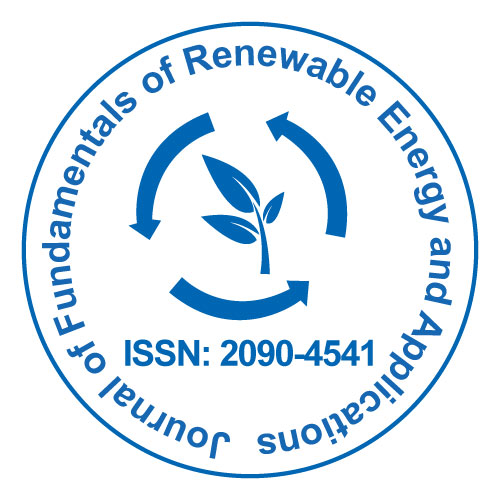
Journal of Fundamentals of Renewable Energy and Applications
Open Access
ISSN: 2090-4541

ISSN: 2090-4541
Commentary - (2023)Volume 13, Issue 1
To keep climate change well below 2 degrees Celsius and closer to 1.5 degrees Celsius, all Green House Gases (GHG) must be reduced, including both CO2 and non- CO2 GHG pollution. In this paper, we incorporate the most recent global non- CO2 emissions and mitigation data into GCAM, a cutting-edge integrated assessment model, and evaluate 90 mitigation scenarios that combine various levels of CO2 and non- CO2 GHG abatement pathways. When non- CO2 mitigation contributions are not completely implemented, we estimate that net-zero CO2 must occur roughly two decades earlier. Comprehensive GHG abatement, on the other hand, that completely incorporates non- CO2 mitigation measures in addition to a net-zero CO2 commitment, can help achieve 1.5°C stabilization. While decarbonization-driven fuel switching reduces non- CO2 emissions primarily from fuel extraction and consumption, targeted non- CO2 mitigation measures can greatly reduce fluorinated gas emissions from industrial processes and cooling sectors. For 1.5°C and 2°C climate change scenarios, our integrated modelling offers direct insights into how system-wide all GHG mitigation can affect the timing of net-zero CO2 emissions.
The Paris Agreement seeks to strengthen the global reaction to climate change mitigation by keeping the global temperature rise this century well below 2 degrees Celsius above pre-industrial levels, and to "continue efforts to limit the temperature increase to 1.5 degrees Celsius." Obtaining these objectives necessitates a strict limit on cumulative Green House Gas (GHG) emissions, which should "reach global peaking of GHG emissions as soon as possible," followed by rapid reductions "to achieve a balance between anthropogenic emissions by sources and removals by sinks of greenhouse gases in the second half of this century." The emission paths are consistent with recent net-zero emission promises, such as China's 2060 pledge, the EU's 2050 climate neutrality pledge, and California's 2045 carbon neutrality pledge.
Recent studies have emphasized the criticality and urgency of achieving net-zero CO2 emissions in order to meet stringent climate goals. Modeling scenarios that avoid global warming of more than 1.5 degrees Celsius, as specified in the Paris Agreement, necessitates combined mitigation of CO2 and non- CO2 GHG emissions. In 2015, non- CO2 GHGs accounted for roughly one-quarter of total CO2-eq emissions. As a result, reducing their emissions could possibly reduce future climate forcing. According to the current literature, the final level of surface temperature warming is determined by both driving CO2 emissions to zero and the residual level of non- CO2 emissions. Although these studies have considered the climate benefits of non- CO2 mitigation, the economic structure of the models, as well as different representations and non- CO2 mitigation options, can lead to a fairly large variation in the reported remaining carbon budget or net-zero commitment years that aim to achieve the same 1.5°C or 2°C goals.
A thorough assessment of the climate benefits of non- CO2 GHG mitigation at the system level is difficult due to the difficulties in identifying and parameterizing the numerous potential mitigation options for different gases emitted from various sectors. Furthermore, some CO2 mitigation and non- CO2 mitigation measures cross sectors.
Extinction of fossil fuels, for example, can decrease both direct CO2 emissions from fuel combustion and upstream methane emissions from fossil fuel extraction. Furthermore, the technoeconomic mitigation potential for each source and mitigation technique is changing as a result of technological advancement. These dynamics may complicate the complete representation of non- CO2 in long-term mitigation research. As a result, a thorough study of all GHG mitigation must combine sectoral and regional detail of mitigation statistics with an integrated representation of the complete economic system, including sectors such as energy, industrial processes, buildings, transportation, urban processes, and agriculture. Others have investigated the validity of the selected model and modelling applications. When the China 2050 DREAM model's underlying assumptions and modelling approaches were compared to other bottom-up energy and emissions models for China, the findings from DREAM reference scenarios were found to be within the range of contemporaneous published energy and emissions outlooks for China.
Citation: Chon K (2023) Mitigation of CO2 and Non- CO2 Gases and Its Variance of Applications. J Fundam Renewable Energy Appl. 13:298.
Received: 02-Jan-2023, Manuscript No. JFRA-23-23334; Editor assigned: 06-Jan-2023, Pre QC No. JFRA-23-23334 (PQ); Reviewed: 27-Jan-2023, QC No. JFRA-23-23334; Revised: 03-Feb-2023, Manuscript No. JFRA-23-23334 (R); Published: 10-Feb-2023 , DOI: 10.35248/2090-4541.23.13.298
Copyright: © 2023 Chon K. This is an open-access article distributed under the terms of the Creative Commons Attribution License, which permits unrestricted use, distribution, and reproduction in any medium, provided the original author and source are credited.